Touring Colombia
Colonial White Towns in a Green Mountainscape
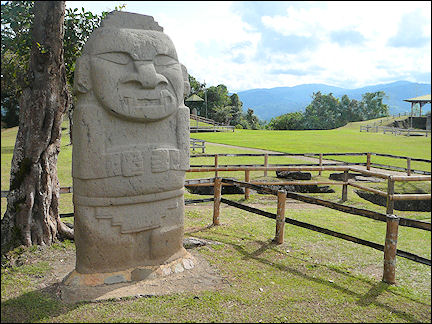
|
From Bogotá to the Tatacoa Desert: cactuses, oddly shaped rocks and prehistoric sites. Santuario de Las Lajas in Ipiales was built on a bridge. Via Popayán and Cali to Salento and Valle de Cocora. Via Medellín to Villa de Leyva, with its archeological park Monquirá. Outdoor sporting in San Gil, then via Barichara and Bucaramanca to Santa Marta in Tayrona National Park: rainforest, bays and beaches. Finally Cartegena with city walls and forts.
Travelogue & photos: Peter van Boheemen
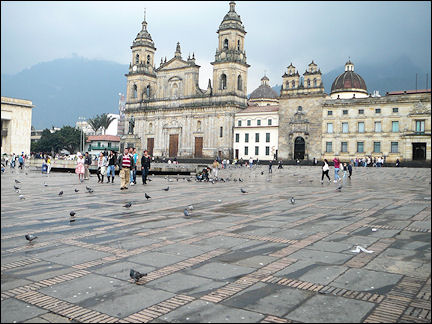
|
My tour of Colombia begins in the capital Bogotá. Only the airplane ticket and the first two nights in a hotel are ooked. Apart from those, everything is open. I don't want to spend much time in Bogotá. It's a city that is too large for my taste and there isn't much to be seen.
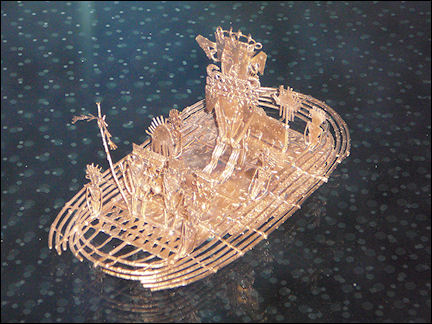
|
But you shouldn't miss the Museo del Oro (gold museum). It has a few "must see" exhibits, like the Balsa Muisca, a 19.5 cm long boat, fine as gossamer, made in 1856. It was found in a cave by farmers, together with some other gold objects.
Tatacoa
This is traveling off the beaten track
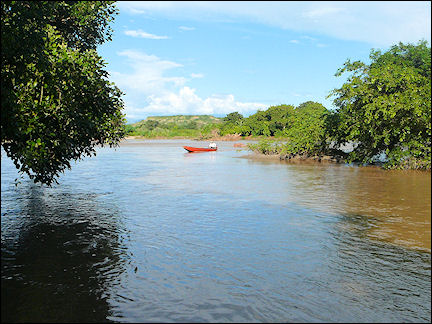
|
I travel south from Bogotá to the Tatacoa Desert. I take a bus to Neiva and ask the driver to stop in Aipe. There should be a ferry to Villavieja. After some asking around, the villagers direct me to an unpaved path and a little later I stand at the Rio Magdalena, alone and desperate. And here should be a ferry?
Just when I decide to walk back to the village, a man approaches who also needs the ferry; he takes me with him. Through the bushes we arrive at a tiny beach, where a really narrow boat arrives a little later. I would never have found this by myself. This is what I call "traveling off the beaten track".
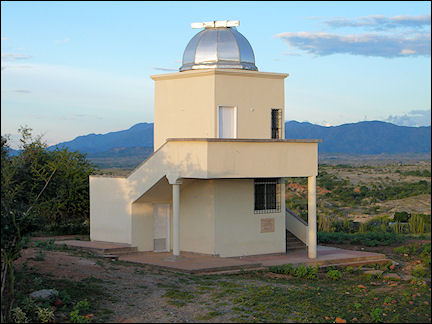
|
When we arrive at the other side, in Villavieja the man offers me to sit on the luggage carrier of his moped and takes me to a hotel. I immediately book tours there. Tonight we go to an observatory and tomorrow to the Tatacoa Desert.
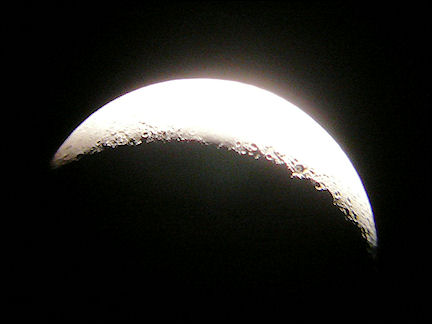
|
Javier Fernando Rua Restrepo is the local astronomist who gives lectures (in Spanish) about the stars. The stars are wonderfully visible here in the Tatacoa Desert, because there is hardly any light pollution. The observatory has some very strong telescopes; you can see the craters in the moon and even Jupiter.
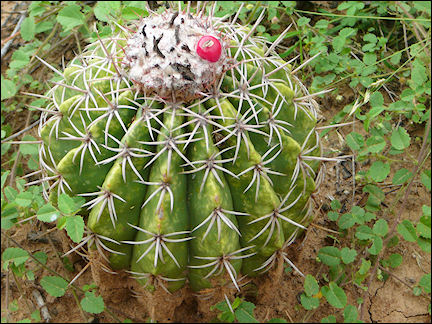
|
The next day I visit the extraordinary desert landscape. Typical for the Tatacoa Desert are the fantastic rock formations, shaped by erosion, and the many meters high cactuses. But there also are small bulby cactuses with red fruits, which I taste.
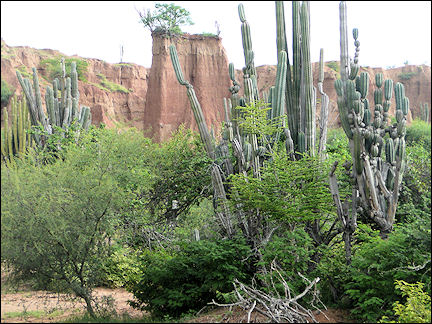
|
I walk with a guide through the red-brown landscape where temperatures can reach the fifties (centigrade). It's not that hot, though, but I have to wear long trousers because of the sandflies.
A jeep takes me to grey rocks in which you can see - with some imagination - a dog and a tortoise. The tour ends where it started, in Villavieja. Here I also visit the Museo Paleontologóco, a dusty museum with displays of local fossils.
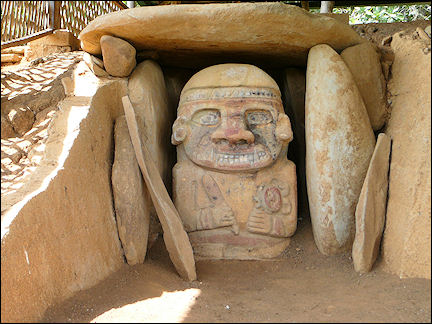
|
A little farther south are the prehistoric finds of San Augustin. These mostly ceremonial pre-Colombian burial places are scattered over a surface of 645 square kilometers and are on the World Heritage list of Unesco. I book a tour on horseback.
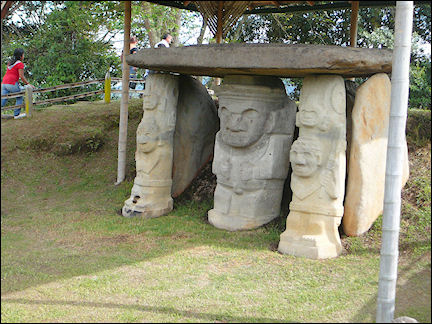
|
For the first time in my life I sit on a one-h.p. quadruped and it's kind of nice. My travel companion on this tour is Sammy, a Canadian who is already a year on the road with his motorbike. We gallop through the green, mountainous landscape and visit some burial sites and statues.
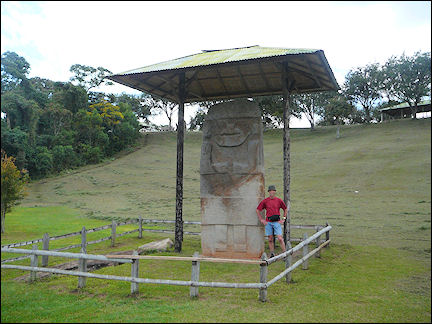
|
The highlight is a visit to the Parque Arqueológico, which has the largest and most impressive collection: 130 statues, tombstones and 500 years old graves.
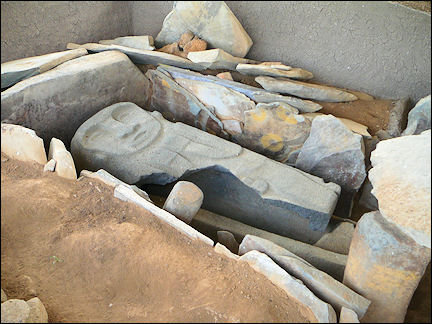
|
I stay in this area for a few more days because I want to take a jeep tour to see some wild nature. In El Estrecho del Magdalena the wild Magdalena River runs through a narrow passage. We also visit more graves and statues, and three waterfalls which are dozens of meters high.
Santuario de Las Lajas
Harmony between architecture and nature
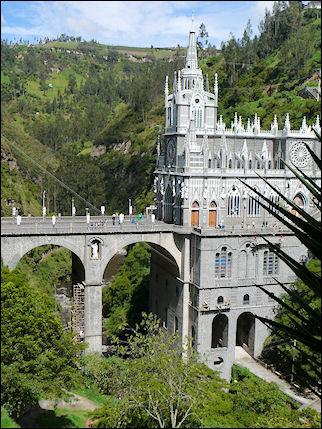
|
The most southern spot I visit on my trip is Santuario de Las Lajas in Ipiales. To get there, I have to ride an ancient bus on an unpaved road. And, as if it's part of the experience, the bus breaks down; but after one and a half hour of tinkering it's good to go again.
Every now and then giant American trucks pass on the other side of the road. Both the bus and they have to go back and forth a few times to be able to pass each other on the edge of hundreds of meters deep ravines. I look down, frightened. If the vehicle slips and goes down the ravine, bus and passengers may never be found.
But I arrive safely, though a little late, in Pasto where I will spend the night. The next morning I find the bus to Las Lajas. Another trip over a mountain road, this time asphalted. The final destination, Las Lajas, is breathtaking.
A river runs through a canyon with waterfalls, over which a bridge is built with on it an impressive Gothic Revival basilica: Santuario de Las Lajas. The harmony between architecture and nature is wonderful. There are many footpaths around it, so you can see it from all sides.
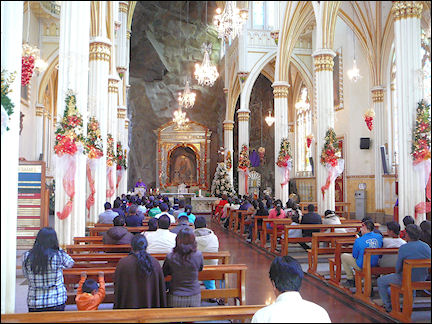
|
Las Lajas is a popular destination for pilgrims. Countless gratitude notes along the entrance path make that clear. To find out more about the history of the church there is a small museum. The church can be visited as well.
Popayán
Fresh-green landscape
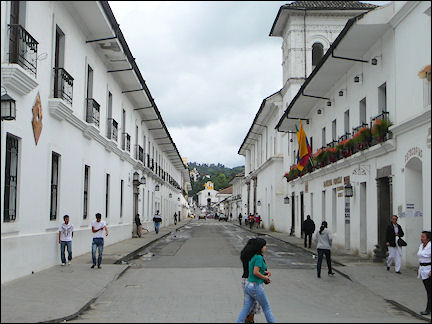
|
I travel back north. Again a spectacular mountain road with dizzying mountain passes. At the end of the afternoon I arrive in Popayán. I plan to get to bed early after this day of travel, but two nice ladies ask me out for drinks in town.
They know a great, authentic café which doesn't seem to have changed at all in the last fifty years or so. It has racks on the walls with countless old vinyl singles in yellowing covers. After visiting here we go to a dancing.
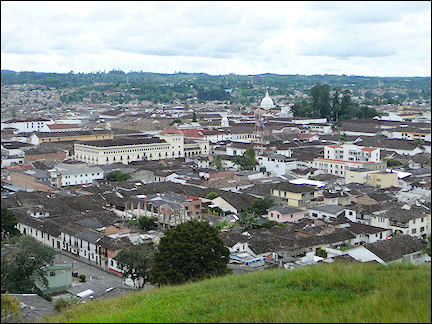
|
Popayán is a landmark town with only whitewashed houses and buildings. It is for that reason nicknamed 'Ciudad blanca'. I take a day to wander around in the streets and museums. A short walk takes me to the hilltop of El Morro, where you have a great view of Popayán.
A visit to the hot-water baths of Termales Aquatibia is a nice excursion. Hot water from the volcanic area is directed through a pipe system to the baths.
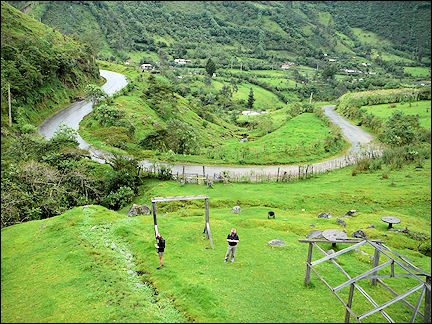
|
I take a pick-up truck taxi there, together with an Irishman, Englishman and a Spaniard. We also take four mountainbikes, because we are going back by bike. After the hot bath we zip down through the fresh-green landscape.
Salento
Hiking and biking
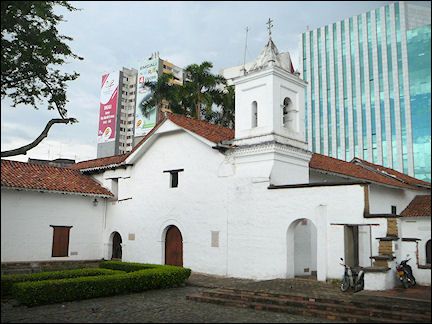
|
I continue on my trip to Cali. I don't find the city attractive. Too busy and except for the zoo and the Iglesia de La Merced there isn't much of interest. In the hotel I meet a German in his early sixties. He had his motorbike flown to Los Angeles, rode it to Panama, put the motorbike on a plane again and is now discovering South America. He really is enjoying his retirement.
Leaving crowded Cali I travel farther north to the rural Salento, a picturesque village surrounded by green nature. I find a homey hotel which looks more like a museum.
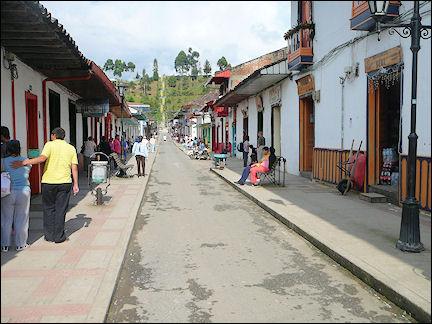
|
There are hiking options here and you can visit a coffee plantation. The paths are soggy because of the large amounts of rain lately, but you can rent rubber boots. A jeep takes me with a group of tourists to the nearby Valle de Cocora, a valley in the central Andes which has several hiking trails.
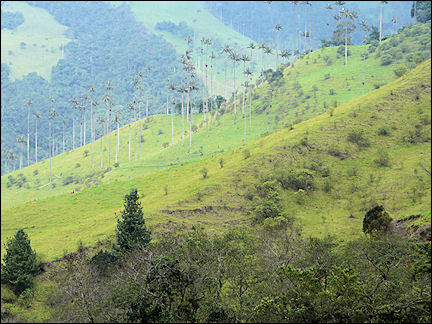
|
I take the longest route, which leads to lake Estrela de Agua. The rubber boots come in handy, especially at the start, where the paths are no more than muddy gutters, because the local population rides here on horseback every day. I find three horseshoes, which I take home as souvenirs.
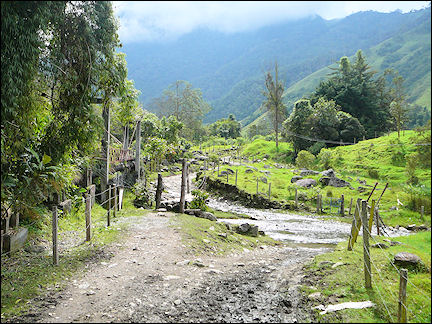
|
This area has the tallest wax palmtrees in the world, up to 60 meters high. The hike to Estrela de Agua is tough, also because you get to an altitude above 3,000 meters. At the summit stands a dilapidated little house, where a young couple offers me tea and food. And it's free!
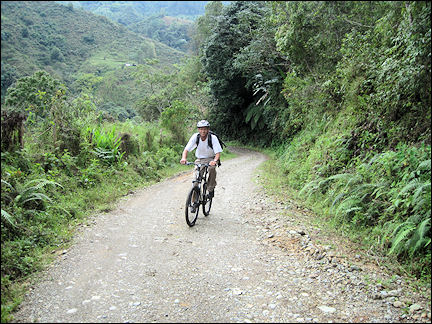
|
The surroundings of Salento are inviting to stay one more day. So that's what I do. Together with Sander, another Dutchman, we rent mountain bikes and take a nice bike route, following the map the bike rental place gave us. Until my bike breaks. After some walking, I get on my bike and let it roll downhill.
We arrive at a busy road with a bus stop. I put the bike in the luggage space and return to Salento by bus. Sander continues on the route. In the evening we drink a good glass of beer and tomorrow I will continue on my trip.
Medellín
The second city of Colombia is very crowded
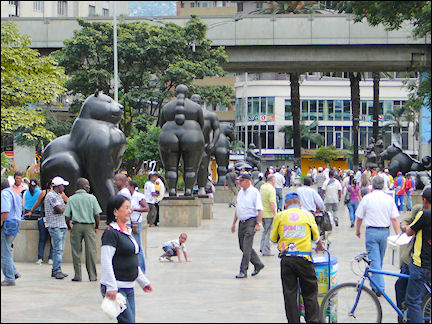
|
Medellín is my next destination. Medellín, with its population of 2.5 million, is the second city of Colombia and very crowded. The only point of interest is the museum of the painter and sculptor Fernando Botero. I want to get out of here quickly.
But that's easier said than done. Because of the large amounts of rain in November some roads have become inaccessible, which means I have to take a detour by bus via Bogotá. Traveling by bus is almost always perfect. There are several bus companies which can take you everywhere in the country. At the sometimes huge bus terminals there are always friendly Colombians to help you and even take you to the right bus if necessary. It's rare to have to wait for departure for longer than half an hour.
Villa de Leyva
The town is very peaceful
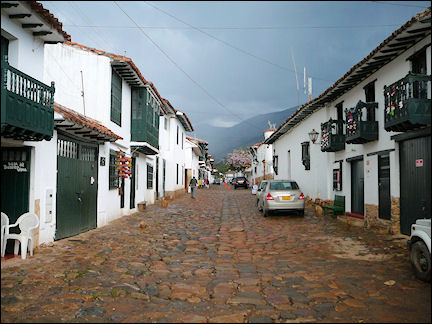
|
After a night in Bogotá my arrival in Villa de Leyva is a pleasant surprise. Villa de Leyva is a relaxed village that looks like an open air museum. It makes sense that it was used as a backdrop for the television show Zorro.
There are many restaurants and bars, especially around the large square at the center of the village. In the middle of the square is a fountain and the Iglesia Parroquial (parochial church) looks out on the cobblestones of the square and the surrounding streets.
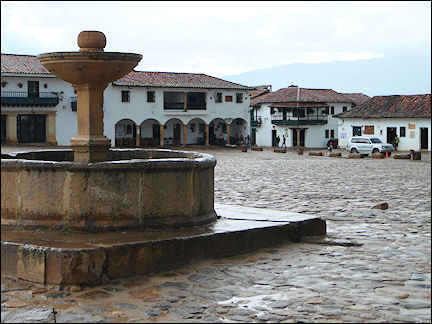
|
Most of the homey houses are white and have red roofs, soft-green window panes, balconies and shutters. The town is very peaceful. And all of this at only four hours driving from hectic Bogotá. No wonder that many Bogotans like to spend a weekend here.
There are pretty hiking routes in the surroundings. Today, I walk to Laguna Iguaque, tough on the calves with steep parts. Sometimes I have to cross fast-flowing streams over rickety bridges made of tree trunks. But it's a very beautiful walk, especially when you get at an altitude of 3,000 meters where lobelias grow and blossom, and where Laguna Iguaque comes in sight. I rest at the lake and return downhill.
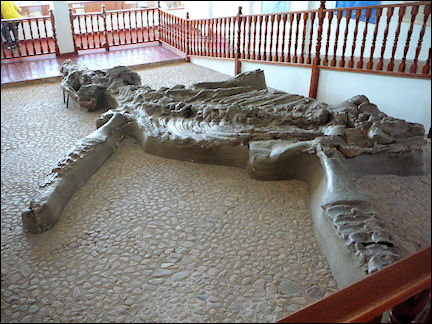
|
Many fossils were found in the surroundings of Villa de Leyva. I rent a bike to visit some sites. A highlight is 'El Fósil', a 120 million years old kronosaurus baby which measures seven meters. Around this marine reptile fossil a museum was build in which also many small fossils are exhibited.
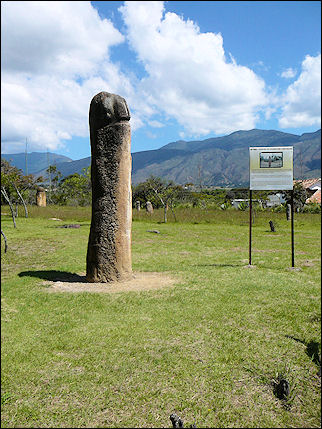
|
Another interesting site to visit is Parque Arqueológico de Monquirá. The most remarkable display here is a large stone penis that stands straight up as a symbol of fertility.
My biking route leads me further to Gran Valle de los Dinosaurus, a kitschy entertainment park with plastic dinosaurs and an educational mission. The entrance fee includes a guide. The girl who enthousiastically educates me about the prehistoric reptiles in her best English makes the excursion worthwhile.
I decide to stay another day in Villa de Leyva to celebrate the New Year. It gets very lively in the local watering hole. At midnight an enormous number of fireworks is launched.
San Gil
A place for active vacations
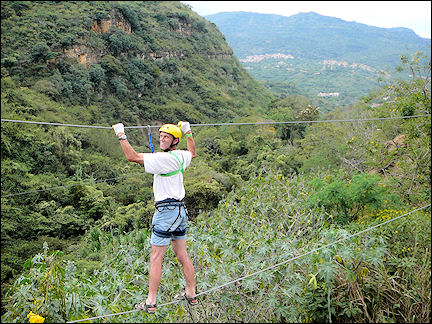
|
It's a little cumbersome to travel on New Year's Day, because there is no regular bus service. But with some extra waiting and transferring, I arrive at the end of the afternoon in the mountain village of San Gil, where I find a nice hotel.
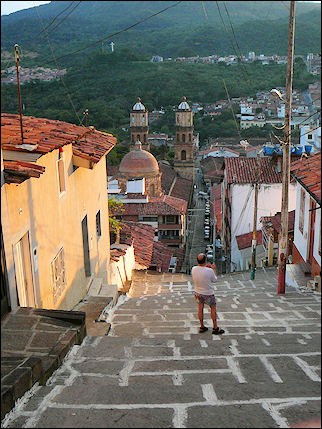
|
San Gil is a place for active vacationing. And so that's what I do. On the first day I go rafting on the Rio Fonce, the river that cuts through the middle of San Gil. I am the only foreigner in a boat full of Colombians which floats down the river. Even though the rapids aren't all that spectaculer, the Colombians are very excited.
There are more exciting things to do: zapping with a zipline, climbing a waterfall and jumping from four meters height in the water and then climb back up with hands and feet along a smooth rockwall.
There is much to see in the surroundings as well. I take a day-trip to Barichara, 20 kilometers southwest of San Gil. Barichara also is a beautiful, small, colonial and authentic village with steep streets and great panoramic views.
Barichara has often been backdrop to Spanish-language movies. Which is understandable, considering that except for a few cars, the place doesn't seem to have changed in 300 years. You only have to remove the cars and you can shoot.
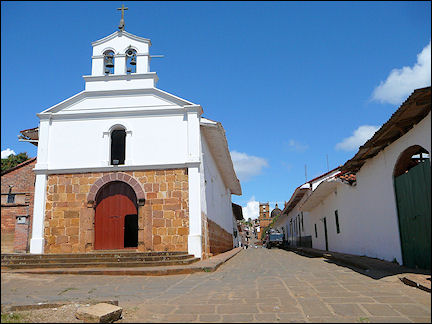
|
From the north of the village a path leads to Guane. There is no shade on this route, so it's going to be a hot walk. In Guane I visit the paleontological museum. The entrance fee includes a Spanish-language guide.
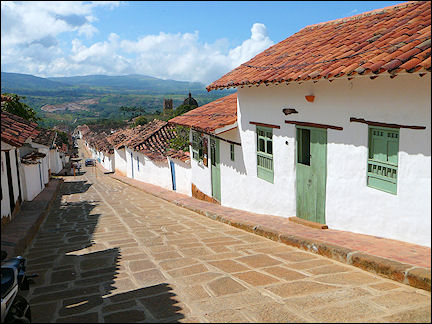
|
The Spanish lessons I took aren't sufficient to follow her fast Spanish. But what my ears can't hear, I can see: there are 7,000 fossils, skulls and a 700 years old mummy.
I don't feel like waiting for the bus, so I walk back to Barichara, where I take a bus back to San Gil.
Bucaramanca
Paragliding close to a waterfall
The northbound mountain road to Bucaramanca again leads over the Andes. The road is busy, but the bus driver does his utmost to quickly pass large trucks and other slow traffic and he is rather successful at it.
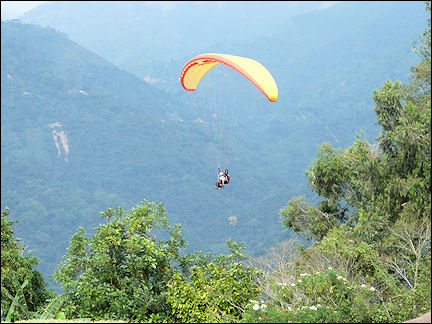
|
I want to go paragliding in Bucaramanca. Upon arrival I immediately take a taxi to the hills outside the city. A 15 minute tandem flight is sufficient to see the panoramic views of the city and the green, mountainous surroundings. My pilot steers the paraglider close to a waterfall. Looking down on the water that splashes down is of course wonderful.
I meet a young Dutch couple who have advanced plans to migrate to Colombia to start a farm here. That really takes guts. I admire their courage.
Santa Marta
A mix of tropical forest, beach and bays
After my paragliding adventure in Bucaramanca I take the night bus to Santa Marta, where I book a five-day hiking trip to Ciudad Perdida.
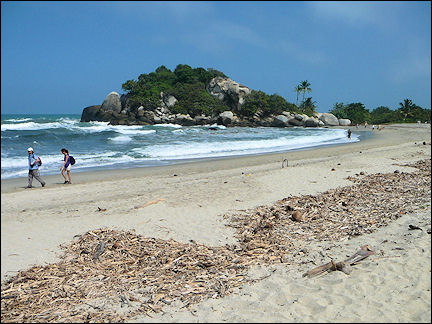
|
There is more of interest around Santa Marta, like the Tayrona National Park, With tropical rainforest, beaches and bays. I reach those beaches over muddy hiking trails. You can spend the night here, too: camping out or renting a hammock. But it is crowded during the tourist season.
A Colombian woman, who has lived in The Netherlands for twenty years, tells me that the Colombians aren't rich, but always seem to find the money for a vacation. I am not a beach lover, but walking from bay to bay here is wonderful. Sometimes I walk on the beach, then again over rocks or through woods.
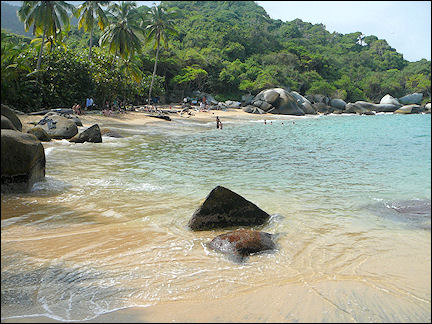
|
When I arrive in Taganga the next day, the bounty beach succeeds in tempting me to lie down on my towel for a few hours. And when a masseuse offers her services I stay for another hour.
Cartegena
OK
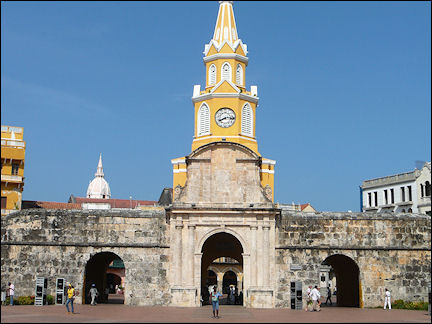
|
Cartegena is both the largest port and the most popular tourist destination in Colombia. The city has much to offer. Cartegena was discovered in the sixteenth century by the Spanish. After a fire destroyed many of its wooden buildings, they were replaced with stone ones and surrounded by a 13 kilometers of city walls, which are almost completely preserved.
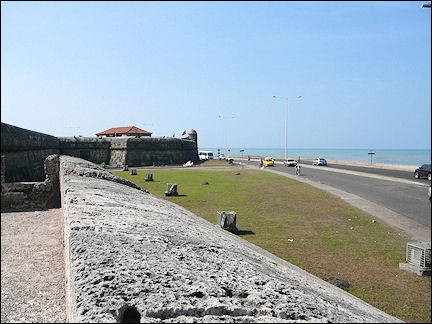
|
A walk along and on these walls gives a good impression of the city's history. And so do the many museums, churches and cathedrals. The beautiful colonial palace Palacio de la Inquisición houses a museum. It displays lugubrous intruments of torture, like thumbscrews and a guillotine.
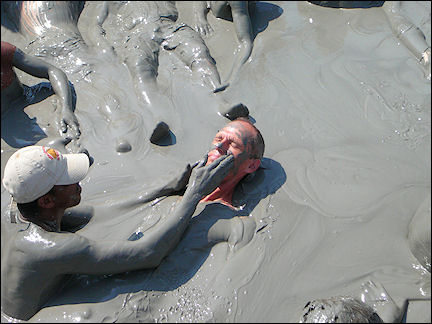
|
The area around Cartagena is als worth exploring. You can take a mud bath at Volcán de Lodo el Totumo, a miniature volcano that doesn't spew lava, but brings up warm mud. I want to experience this for myself, and so do many other tourists. We drive there in a packed bus.
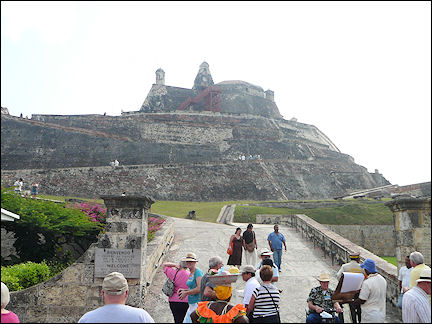
|
Upon arrival we get in line and go up, where a kind of conveyor belt takes us one by one to the mud bath, after which we get a simple massage in the warm blubber. I don't believe in its healing or preventive power, but it's fun. Women wait for us at a lake where they rinse the mud off our bodies.
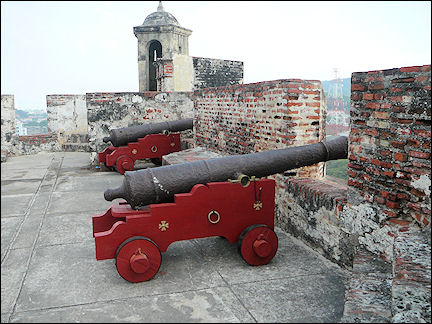
|
I still have seven days for Cartegena and enough time to see everything. I visit the Spanish forts. Castillo de San Felipe de Barajas is one of the largest ever build by the Spanish in their colonies. It was build by slaves and took 121 years to complete. I walk to it via the Heredia Bridge.
The fort is in a perfect strategic position on the hill top of San Lázaro. It has a great view of the city and the bay. It fullfilled its function of defending Cartagena excellently. Edward Verron tried to take the city with an army of 23,600 and 186 ships in 1741. They reached the defensive wall, but the canons at the fort shot 70 of their boats to the smithereens.
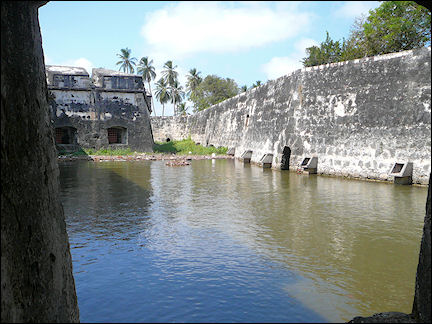
|
Fuerte de San Fernando on the isle of Tierrabomba is muh smaller, can only be reached by water taxi and is therefor much less of a tourist attraction. But it's still worth a visit. This fort is also in perfect condition. It has a moat and an underwater wall. It took a lot of effort in colonial times to keep pirates at bay.
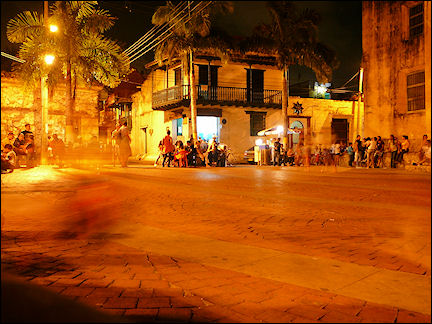
|
At night it's busy in the outdoor cafés of the old city center. A small square outside the center, in front of Iglesia San Trinidad has a village atmosphere. People get together every night to buy a beer or something stronger in the supermarket and then sit down on a bench to watch the passers-by.
Sometimes I have nice conversations with other tourists or I practice my Spanish with the locals. Other nightly entertainment can be found in bars in a street called Media Luna.
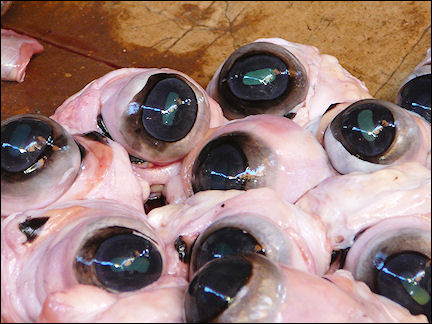
|
In the daytime I don't get bored either. There is always something to do in Cartagena, like a visit to the Mercado Bazarto. The chaotic market, three kilometers from the city is extremely filthy in some places. Especially the meat and fish departments could turn you into a vegetarian, especially when I see that cow eyes are on offer at the butcher stores.
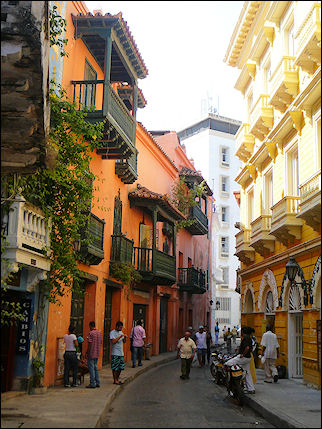
|
Or I go to the beach. The peninsula of Bocagrande is build up with highrises, but also has some kilometers of beach. Many masseuses and pedicures try to make a living here. Before you know what happens, someone is kneading your shoulders: 'Oh señor, you have much stress, you work too much. You need massage!' But these massages are too expensive in relation to their meagre quality.
After seven weeks, this really is the end of my vacation. I take a domestic flight back to Bogotá and fly home from there.
My opinion of Colombia matches that of the ever friendly and proud Colombians: Colombia es chévere! (Colombia is fantastic!)
Part of this tour was a Jungle Trek to Ciudad Perdida.